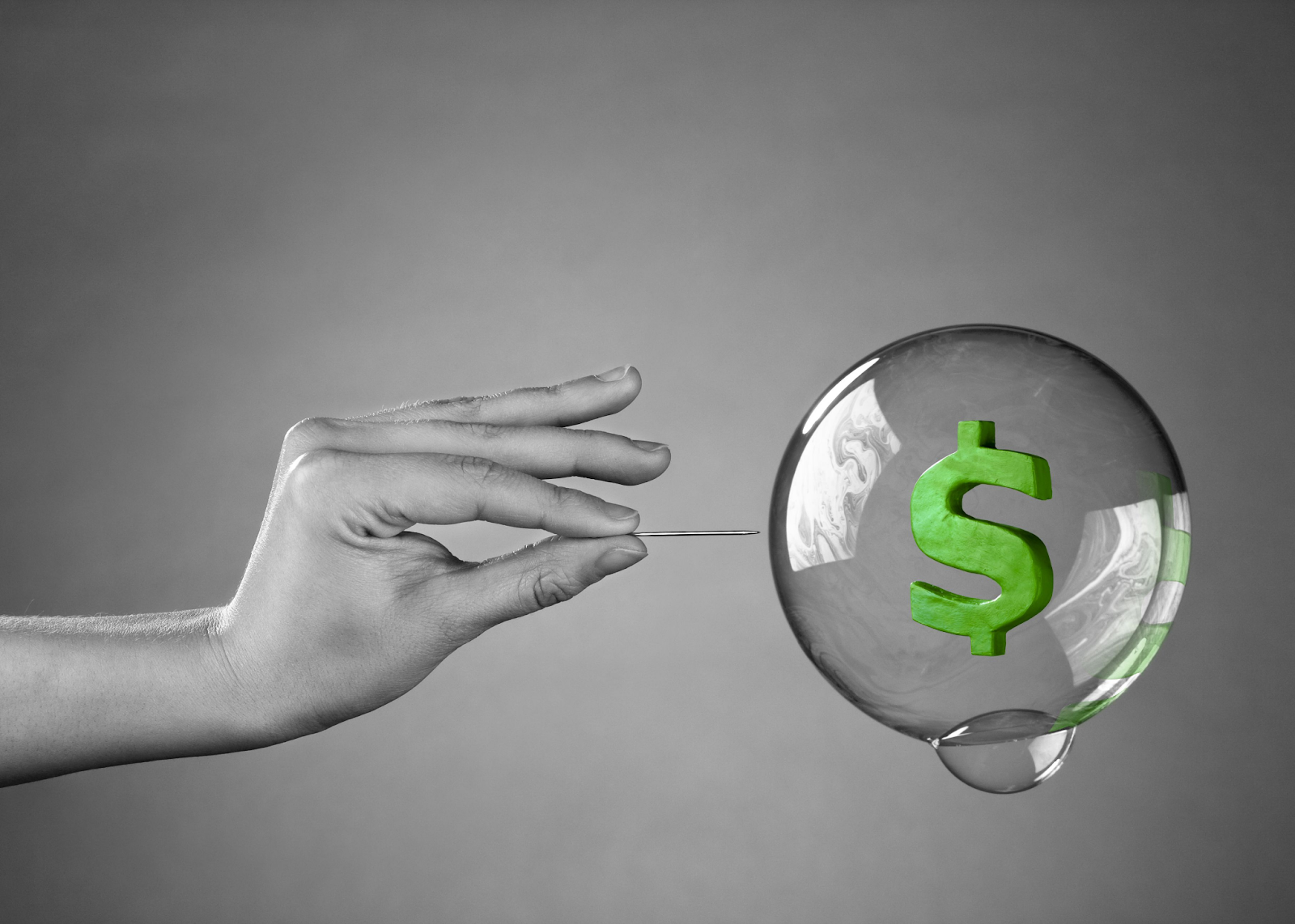13 Sep 2022
Definition Types & 5 Stages of Economic Bubble

Our economy has experienced several economic bubbles throughout history due to some basic human principles. Constantly, the perceived value or price people are willing to pay outweighs the intrinsic value of goods. The Definition, Types & 5 Stages of Economic Bubbles highlight how these bubbles usually collapse after a sharp fall, followed by an economic crisis that leads to depression and recession.
John Maynard Keynes, regarded as one of the most prominent economists of the 20th century, once said that economic cycles are inevitable and that spontaneous optimism drives the economy more than mathematical rules.
Since Economic Bubbles are unpredictable and deceptive, understanding their Definition, Types & 5 Stages of Economic Bubble is essential for investors or traders to grasp the fundamentals and strategies before investing.
NIWS: National Institute of Wall Street is a top-ranked stock Market Institute In Delhi with highly trained, certified, and experienced expert stock traders. We aim to prepare our students with the best course for economic bubbles and modules approved by the NSE, NCFM, BSE, SEBI, and NISM. In addition, we offer promising career opportunities with a 100% job placement guarantee.
Hence, let us discuss in detail economic bubbles in the share market, how they usually develop, their stages, and their types.
What is the Economic Bubble?
The term "bubble" in economics refers to a situation in which the price of individual stocks, assets, entire sectors, and asset classes substantially exceeds their intrinsic value. Often, these rapid increases are followed by rapid declines in value or contractions, called "crash bursts" or "bubble bursts."
To protect their investments from sudden price fluctuations, investors must thoroughly know powerful stock trading strategies. These strategies help investors have a backup plan to balance their losses from market volatility.
Types of Economic Bubble
1) Stock Market Bubble
This type of bubble forms when the price of a private company's equities, shares, and EFTs rises beyond its fundamental or intrinsic value. A good example is the dotcom bubble in the late 1990s, fueled by internet-based businesses.
2) Asset Market Bubble
Generally, this type of bubble occurs in industries outside the equities market. Real estate is an excellent example. Cryptocurrencies like Bitcoin, Litecoin, or even traditional currencies like the US dollar or euro also fall into the Asset Market Bubble.
3)Credit Bubbles
A credit bubble involves a sudden surge in consumer loans, debts like debentures, bonds & other forms of credit.
For example, credit bubbles occur when interest rates decrease, or debt instruments offer higher interest rates.
4)Commodity Bubbles
Commodity bubbles involve a rise in the prices of hard and soft commodities. Some examples are gold, soybeans, gas, oil, crops, and metals.
5 Stages of Economic Bubble
Bubbles are usually observed after they have occurred since their signs are not always obvious. Since Hyman P. Minsky- a rewarded American Economist and Professor, discovered these stages, let's discuss them briefly.
1) Displacement
It occurs only when a paradigm enraptures an investor or trader or when investors/traders get distracted by new technology or trends. Let's understand this stage with a classic example: If the lending percentage rate on home loans falls, people will take more home loans for their property, but this high demand will eventually increase property prices.
2) Boom
During this stage, prices rise slowly, gaining momentum over time as more and more participants enter the market, setting up a boom. At this stage, the asset being questioned receives media attention and growing fear that one might miss out on a once-in-a-lifetime chance, causing more investors to join in the fold.
3) Euphoria
In this stage, all your family members, friends, and neighbours will admonish you to get into the game. It's the phase where caution is tossed to the wind. Everyone simulates that they can become wealthy quickly. Risk is taken without hesitation, and nobody worries about the morning hangover.
The feeling of Euphoria causes people to believe that good times will never end—just as when people thought they could earn more money trading Ipos rather than going to work during the dot-com bubble.
4) Profit Taking
As soon as investors realize that the euphoria bubble is about to burst, they sell their assets and make a good profit.
5) Panic
Upon realizing that everyone is selling, panic sets in. As rapidly as asset prices had risen, they decreased as well.
Example of Economic Bubble
Tulip Mania
-
Tulip mania is believed to be one of the first economic bubbles in history.
-
Tulips were introduced to Holland, with the bubble occurring mainly between 1634 and 1637.
-
Due to their bright and varied colours, tulips were highly priced and were a sign of success.
-
Generally speaking, the more colourful and rare a bulb was, its value was more remarkable.
-
Because of their dark line patterns, the most expensive varieties of tulips were called flame tulips.
-
This variety was supremely coveted.
-
Unfortunately, their spectacular colours were not caused by genetics but by a Mosaic virus that infected them.
-
During the peak of the mania, bulbs were sold for six times the average salary of that time.
-
To make more money from this madness, merchants created a secondary futures market where people could buy and sell tulips without owning them.
-
For the first time, an auction of tulips failed to draw enough buyers, ending the tulip craze.
-
Many people suffered losses during the 1637 bubble burst.
-
These people had mortgaged their houses, lands, and savings to buy a few tulip bulbs.
Dot-Com Bubble
-
A few bubbles in history can match the dot-com bubble in terms of sheer size and scale.
-
With the passing 1990’s second half, internet stocks began to rise rapidly.
-
In the aftermath, hundreds of dot-com companies became publicly traded and achieved multibillion-dollar valuations.
-
The NASDAQ index increased from 743 points in 1995 to a peak of 5,048 by March 2000. It was more than doubling its value in just six months.
-
The NASDAQ lost 78% of its value in 2002 due to the bubble burst. Most shares in internet companies also saw their prices plummet.
-
The tech-heavy S&P500 saw its value nearly reduced by half, and shockwaves were felt all over the globe.
US Housing Bubble
-
A rapid increase in home prices in the US housing market by the mid-2000s caused a bubble.
-
In the hope of making a profit from their homes, speculators started to flip them.
-
The price of a home in the United States increased by almost 80% from 2000 to 2006.
-
However, people who couldn't afford homes started buying them, and eventually, the bubble burst.
-
Housing prices took about ten years to recover fully.
Conclusion
Identifying an economic bubble in real time is impossible, so investors should be cautious when investing in upward trends. If prices rise, check the assets' fundamental values before investing in them. Ensure the price you pay for a particular stock is worth the investment.
One should also understand financial ratios like price-to-equity or price-to-book ratios to determine whether a stock is overvalued or undervalued. All these things are only possible when an investor knows the basics of the stock market and the company's stock they are dealing with. NIWS offers the best stock market classes in Delhi, where an investor or trader can learn all the stock market strategies and facilitate intelligent investments.
Book your Free Demo with our experts to clear your queries and discover how our expert tips will help you with promising career opportunities in the stock market.
FAQ
Q. 1 How can you tell if there is an economic bubble?
Ans:
- An insufficient amount of research is done before purchasing securities (purchased based on belief).
- Financial results become less critical than company stories.
- There is a far-fetched vision of a bright future portrayed by charismatic leaders far away from current reality.
- For many years, doubters have been portrayed wrong and disregarded as people who "just don't understand."
Q. 2 Is the stock market in a bubble in 2022?
Ans: We can't predict whether the stock market will be a bubble in 2022. However, the underlying economy appears to be growing despite some concerns. Wise investors need to stay committed to their overall finances and keep investing for the long term.
Q. 3 When a bubble bursts, what happens?
Ans: When a financial bubble bursts, the price of an asset or stock drops to its intrinsic value or even lower—an abrupt drop in price results in a stock market crash. Investors can incur massive losses, and the economy can undergo a recession.
Q. 4 What causes an economic bubble?
Ans: The economic bubble occurs when an item's price rises far beyond its fundamental or intrinsic value. Some of the financial bubble examples are
-
Tulip
-
Dot-com
-
Gold
-
Baseball cards
